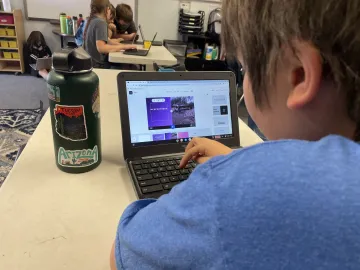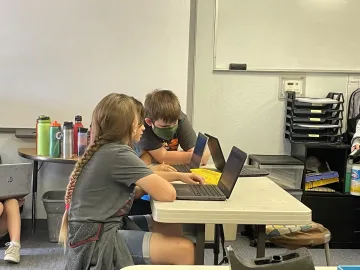The CREATES Literacy Project mobilized existing community-university partnerships between the Women in Science and Engineering Program, AZ Project WET, and local K-12 schools in order to increase access to culturally-responsive and place-based STEAM educational programming that helps students build competencies in critical thinking, science communication, and creative communication technologies. In order to enable the integration of literacy and creative-communication into science curriculum, 3rd through 8th grade educators developed modules designed to build upon already tested science units. These modules were implemented in Spring 2022 and Fall 2022 with the support of University of Arizona student workers trained on culturally-responsive pedagogical strategies and creative communication technologies through The Bio/Diversity Project.
The CREATES Literacy Project was generously funded by the Stocker Foundation from 2021-2022.
Click here to view an example 7th/8th grade literacy and science integration module created by our Spring 2022 program participants.
Borton Magnet Elementary School - Investigating the Urban Heat Island Effect
At Borton Magnet Elementary School, 5th grade students explored the Urban Heat Island effect and were given the opportunity to relate this topic to their local environment. Students first recorded temperature data from different surfaces all around the school and then discussed their observations with their peers and instructor. The students were then introduced to the literacy strategy of summarizing in science while they read an article about the urban heat island effect. This was used as a way for the students to be able to practice summarizing a text in their own words. Lastly, students responded to the prompt: “What would happen if BELL were turned into a parking lot?


Butterfield Elementary School - Monarch Butterfly Conservation
At Butterfield Elementary School, 3rd grade students in Jo Anna McCormick’s class explored summarizing in science through a reading about Monarch butterflies. The lesson was prefaced with a personal anecdote about how sometimes the readings in science can be really long and complicated and how the strategy of summarizing can be really helpful. The students were then handed a reading about Monarch butterflies that was divided into multiple small sections with room to write a summary sentence about each section. Jo Anna McCormick then led the students in reading the first section of the article out loud. She then showed the students how to pick out the important parts of the section and write it into a summary. This process was repeated for each section, and with each additional section, the students were given more independence in their summarizations. At the end of the article, the students then compiled their summary sentences into one summary paragraph for the entire article, which was turned into a personalized Adobe Spark video for each student. See below to view a video created by one of Jo Anna McCormick's students on monarch butterflies.


C.E. Rose PreK-8 School - Flower Anatomy & Dissection
Students explore the parts of a flower and their functions through a guided dissection activity that has each student dissect and label each part of a flower. Card sets are used alongside the activity to connect physical and graphical representations of these parts. Students then demonstrate their knowledge by coloring in each part on their card set, creating a guide that can be used for reference as well as to test their knowledge. See below for an example of a student's work.



Flowing Wells Junior High School - The Importance of Biodiversity and Building an Outdoor Classroom
|
At Flowing Wells Junior High School, 7th and 8th grade science students in Patrick Taylor and Caitlin Brenton’s classes explored the importance of bats as pollinators in the Sonoran Desert. Over the course of 4 days, students learned about different Sonoran Desert species, particularly focusing on pollinators and why they are important. Taking advantage of the outdoor classroom that the school has, students participated in a Bio-Blitz activity on the first day of the project in which they used the Seek by iNaturalist app to identify local species of plants and animals and learn facts about them. CREATES Literacy Project interns from the University of Arizona were at Flowing Wells Junior High on this day to support the lesson and assist the students in using the app and finding facts on the species they identified. On the second day of the project, students utilized the literacy strategy of summarizing in science to read through an article on bat conservation. On the third day of the project, students were tasked to create TikTok videos to demonstrate their knowledge of bats, why they are important pollinators in the Sonoran Desert, and what they can do to promote bat conservation. This day the interns from the University of Arizona were also there to support the students while they created their videos and were even asked to be a part of a few of the videos to give information on bats and the Sonoran Desert. On the fourth day of the project, students edited their TikTok videos and shared it with their peers. See below to view one of the TikTok videos made by some of the Flowing Wells Junior High School students. Video file
Image

|

Tucson Country Day School - EarthWorks Project
At Tucson Country Day School, 4th grade students in Krista Young’s class were given the opportunity to utilize the creative communication tool Adobe Spark to demonstrate knowledge on prior lessons for the Champion Showcase projects. Students were given the opportunity to work with the University of Arizona interns to generate a project idea, plan, and ultimately create an Adobe Spark video. These videos primarily focused on the concept of Earthworks and biodiversity.



